Good morning ! ok metal is resonant but what matters is the spectrum/frequencies of the resonancesThe problem with metal is that it's resonant from nature. It's very stiff, but also very resonant. How to damp that is the difficult part of it. Genelec does it, and some others also, but many diy attempts fail. Wood is so much easier.
If i place a very powerful woofer in a metal very rigid cabinet i run a high SPL sweep and i see that the resonances show lets say above 500Hz it will be just a matter of use a low pass filter below that point
The woofer will never reproduce frequencies that generate resonances Done !
Actually this is the test that i have in mind Probably if the cabinet is not rigid enough the resonances will show up at a much lower frequency
This what they do with complete speakers at Stereophile
This is the result of a pretty much ideal speaker cabinet
https://www.stereophile.com/content/rockport-technologies-antares-loudspeaker-measurements
my accelerometer could be the liquid place above the speaker
the principle is that we hear the box if some parts of the box vibrate If they do not move even with high SPL is done
instead some other speakers are shaking like dancers
Thank you Guys !
I use my C902 mainly for quick loudspeaker testing or evaluation (FS measurements, adverse noises detection problem, humps and resonances in the response, etc...). It came with its complete Marine Nationale user, building and service documentation. And I have two other C902 in working order, stored for parts, just in case...
There was a second, relooked version in the early 60s :

T
I use my C902 mainly for quick loudspeaker testing or evaluation (FS measurements, adverse noises detection problem, humps and resonances in the response, etc...). It came with its complete Marine Nationale user, building and service documentation. And I have two other C902 in working order, stored for parts, just in case...
There was a second, relooked version in the early 60s :
T
@ginetto61 : let's build two cabs, same volume, for the same speaker (say a good 8" to 12"), an adequate Bass-Reflex of significant size, built without any bracing...
1 - in 19mm MDF.
2 - in 20mm Steel sheet or plates.
It's an experiment that I would have done years ago, when I was working with some cooperative and interested boilermakers... The problem that stopped me (us) was the handling ! 😱 😕
T
1 - in 19mm MDF.
2 - in 20mm Steel sheet or plates.
It's an experiment that I would have done years ago, when I was working with some cooperative and interested boilermakers... The problem that stopped me (us) was the handling ! 😱 😕
T
of course parts have to resonate But it is the cabinet that should not It is a tech challenge There is a lot of interest in cabinet design and built i guess for a reasonJust for your perspective:
Any loudspeaker driver (in or outside a box) is resonant.
Adding a bass reflex tube or a passive resonator (sic!) adds an additional resonance. Transmission lines are resonators.
So resonance must not generally be a problem as such.
My interest has skyrocketed after some primitive tests I was sincerely amazed to hear how just adding some mass to a speaker changed its sound
I had a pair of old Mission 70 I broke the woofers Then my friend mounted two midwoofers and add some lead to the cabinet
There was not much bass below 100Hz but the sound was very clean Impressive And detached from the cabinets in a very fascinating way
There is nothing worse than a boxy speaker
if you add mass the resonances will move down in Hz It is just a matter to add an high pass filter and the speaker will never reproduce the frequencies that can generate resonancesAdding weigth will increase the inertia of enclosure material, but it does not "absorb" vibration. It cannot do so, where would the energy go to?
This is why i love the two pieces solution Because the bass woofer cabinet must be stiff and the midhigh cabinet must be heavy
Instead if you put all drivers together you must have a blend of stiffness and mass It can be done but it is more difficult
therefore aluminum for the woofer cabinet and HDF for the midhigh cabinet and its done
who said that a speaker must be monolithic ?
to an extreme any driver could have their own cabinet specifically designed for the range covered by the driver
this is why i do not like woofers mounted in towers with long extended panels Towers speakers are not interesting to meHigh weigth will be excited less, of course, but once excited it will oscillate longer.
Just imagine a heavy iron weigth hanging on a long wire. It takes some force (and work/energy) to move it significantly, but once it swings it will swing for a long time!
yes you are right The ideal is not real There will always some kind of resonances But when their level is very low they do not cause problemsEdit: it may sound like I am constantly nitpicking, but I just want to point out that resonances cannot be completely avoided, even with very heavy enclosures. You just need to know whether a resonance will be a problem and how to deal with it.
Edit2: a post showing negative impact of port resonances in my port resonance absorber and geometry thread.
as i said when the cabinet is well done the speakers will be felt like disconnected from the amps Switched off
and the sound will come from the space around them
Wilson speakers for instance are very good at this Their cabinet is meticoulusly designed and built
hi very interesting and great creations indeedI'll mention two of my DIY enclosure ; the 375L and the 475L (below)
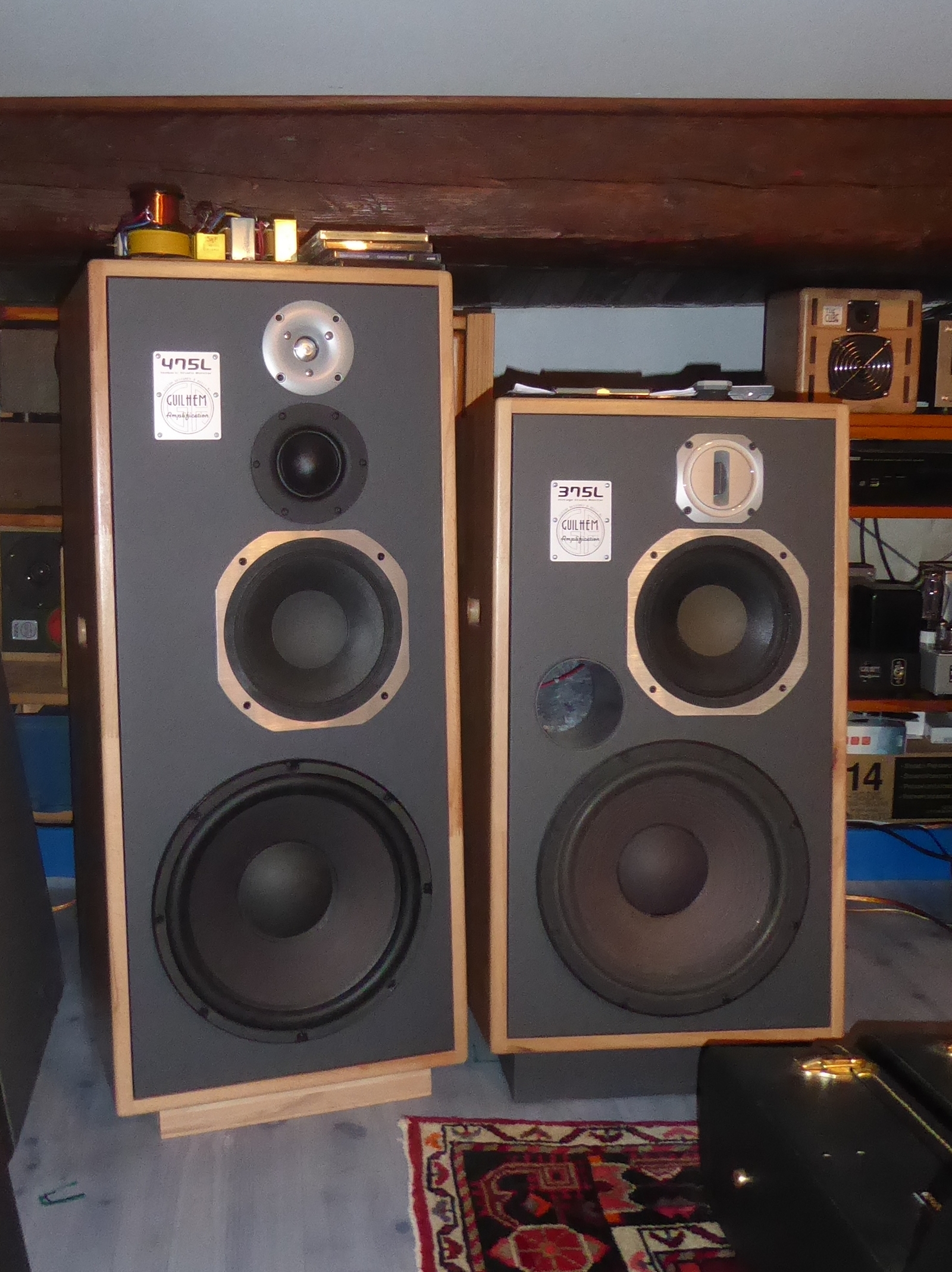
Here's how is built the 375L (Bass-Reflex type)
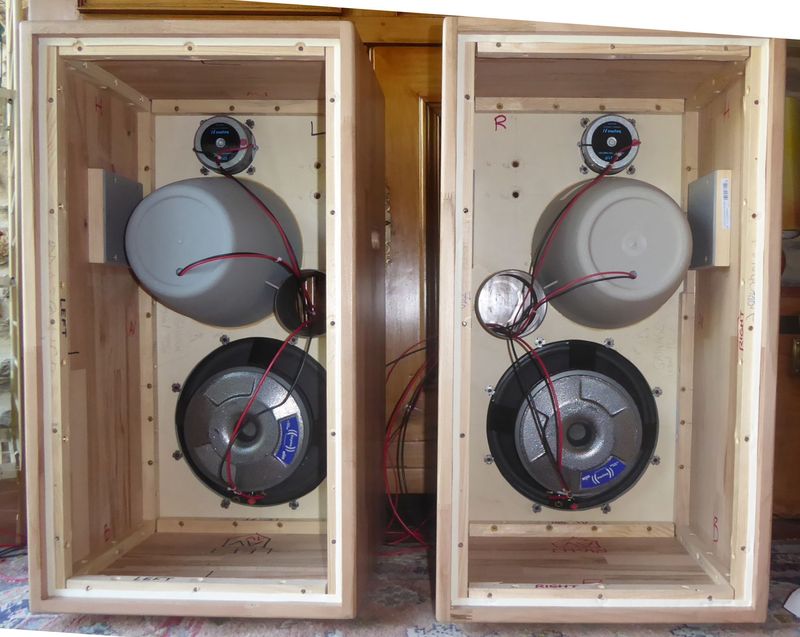
And the inside filling (40mm Cotton Wool mattresses) :
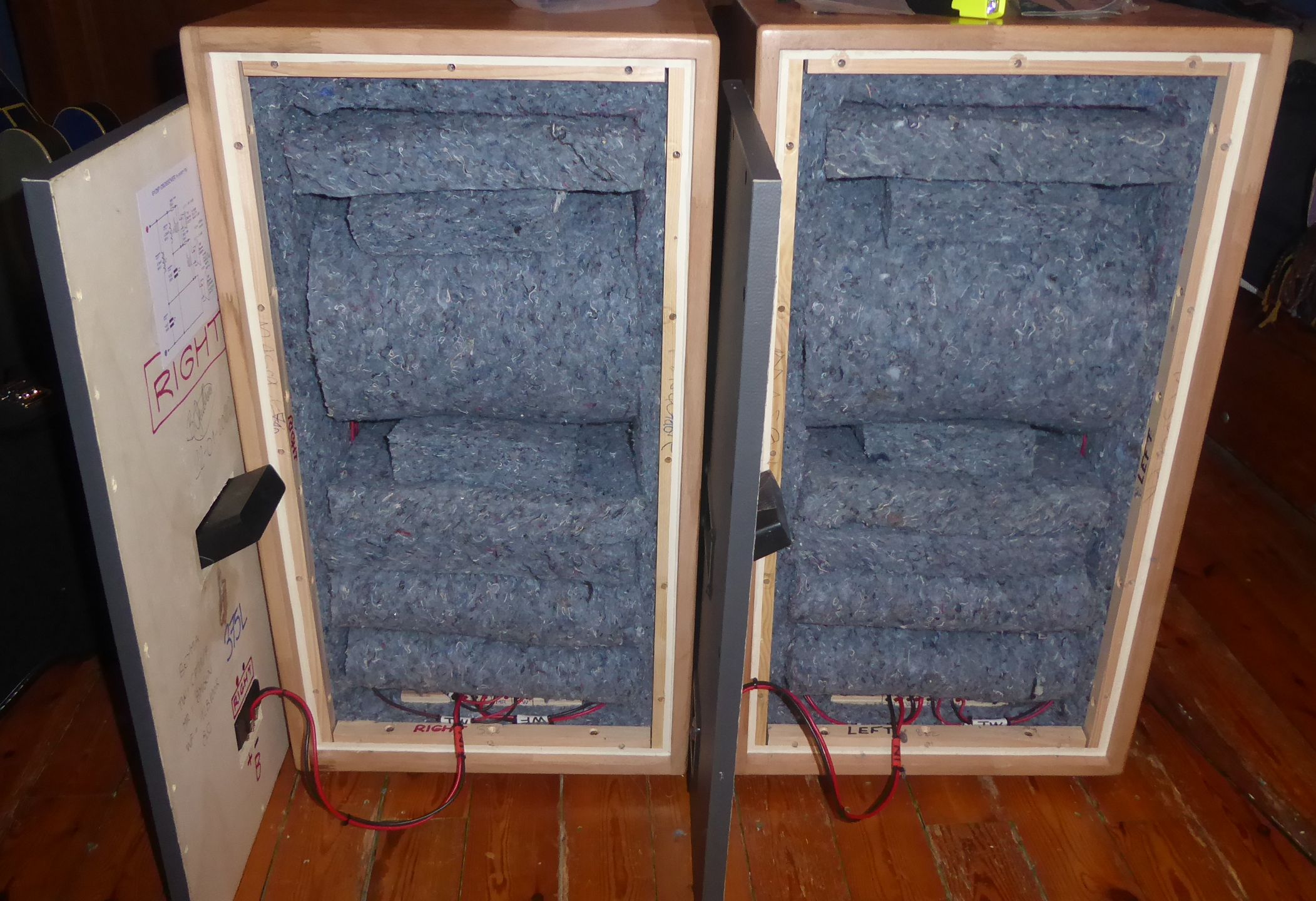
Here's how is built the 475L (Isobaric sealed type)
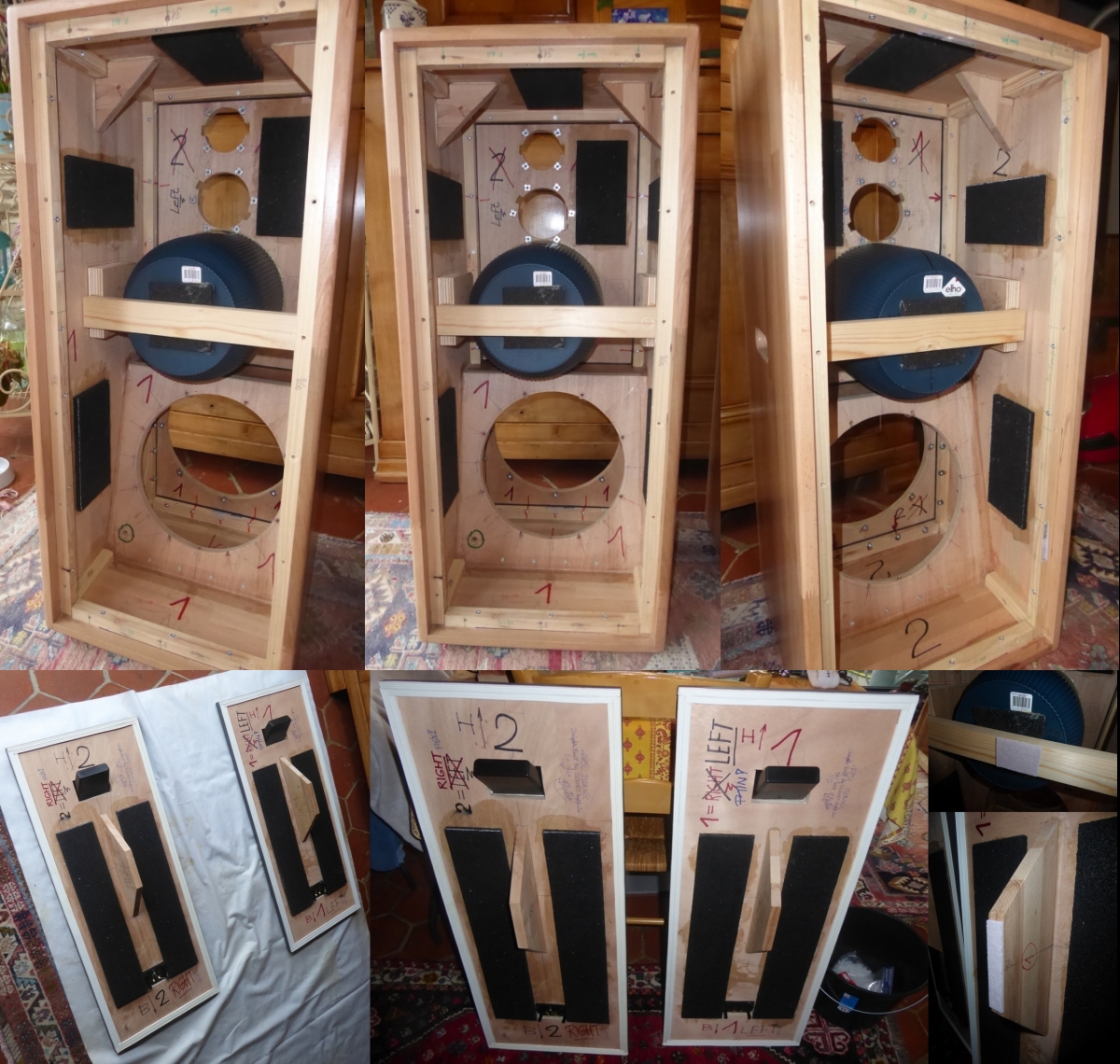
And the inside filling (40mm Cotton Wool mattresses) :
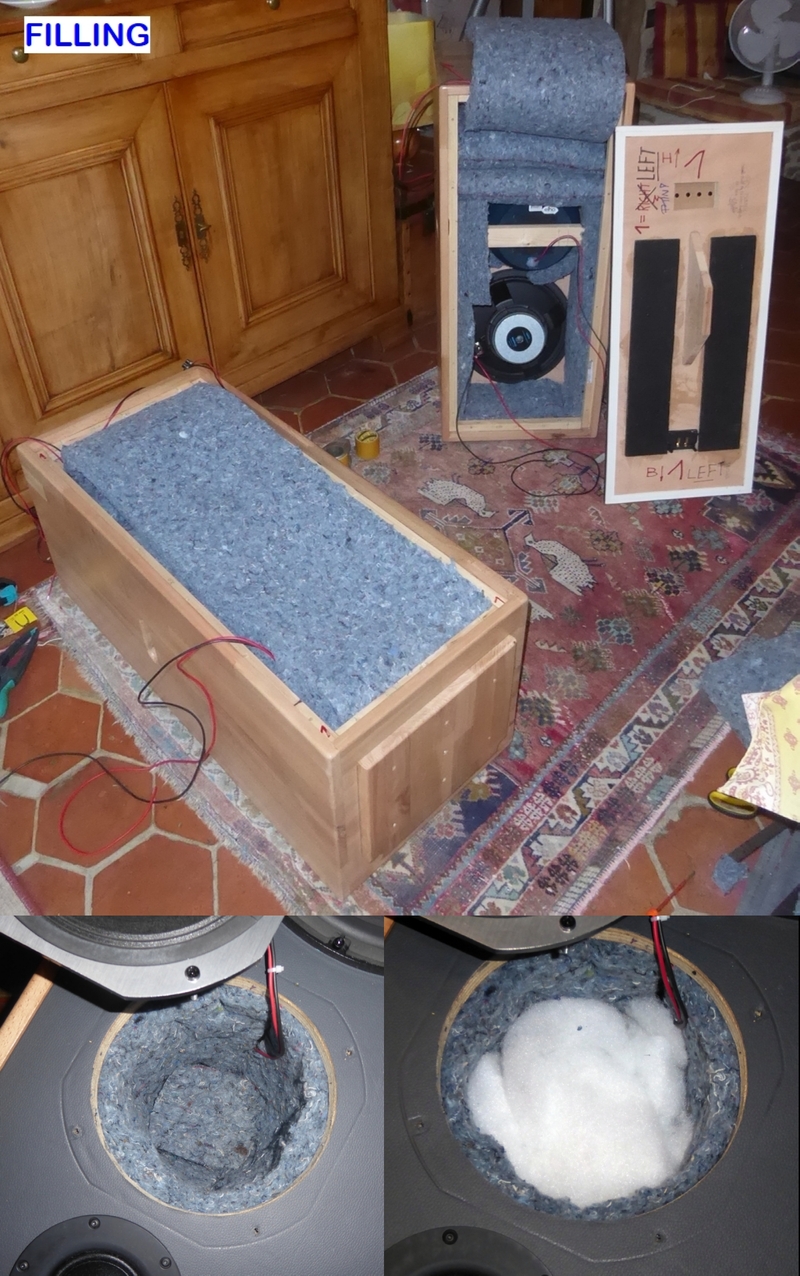
As you can see on those pictures :
* The 375L has no particular internal bracing, nor vibration damping material installed on the panels.
* The 475L benefits from panel-to-panel bracing, plus glued vibration damping material sheets.
Do I observe any tonal differences between the two cabinets ? That would be the question, and the answer is : non significative in terms of cabinet, tonally speaking, because the two speakers are from a different type, and just this provide much difference ortherwise, well over the cabinet construction by itself - even if the same materials were used for both.
Do I observe tactile vibrations of the panels at low volume ? Say comfortable, endless unfatiguing loudness 😊 = Nothing can be felt on any of the cabs.
Do I observe tactile vibrations of the panels at high volume ? Say temporary high "demo" loudness, the limit you can bear not too long= there's moderated vibrations on both as expected, the 375L having a bit more vibrations vs. the 475L, because of the absence of panel to panel bracing. I would have found a more conclusive tactile difference, though, and at the disadvantage of the non-braced 375L.
What I can say here, is that no Boxy / Boomy sound is to be deplored, nor on the 375L, nor on the 475L, possibly because of the principles used (Isobaric QTC=0.7, low-tuning BR), the sufficient stifness of the panel material (Glulam Beechwood), the size and the proportions of the enclosures (heights 900mm and 750mm)...
That's why I rather subscribe to what @NIXIE62 wrote on post #110 :
View attachment 1398715
T
i proposed a trivial VERY QUALITATIVE test to check for some panels vibration to stick with a biadesive tape a little mirror to the panel to check
then take a laser pointer and direct the beam on the mirror from an angle
If the reflected point will shake running a sweep it means that the panel is vibrating I think that this could show also at which Hz the resonances are higher
I know it can be a silly test but cost nothing Only the signal generator I am buying one but i need one that has a knob to change frequency
Maybe all have that ? i will ask immediately in the relevant section
Hi very nice Impressive equipment indeedSure 😀 😎 ! Have a look to my (French Navy) FERISOL C902 Audio Generator from 1953, which is my "speaker tester" :
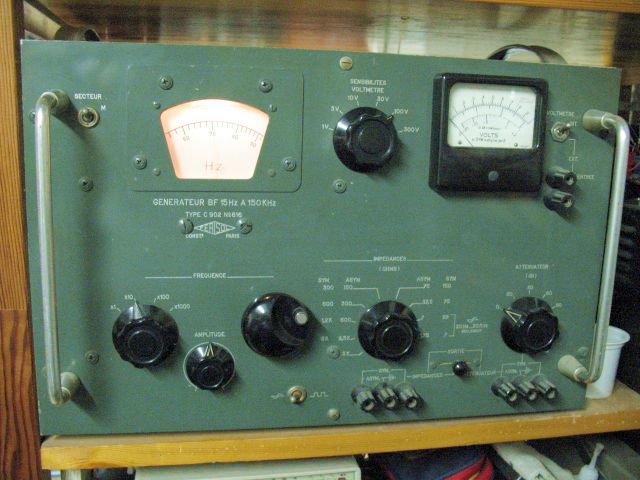
A full tube, Wien bridge oscillator, 45kg unit, fitted with a 6L6GC at the output stage, and switchable impedance from 5K to 1.75R, able to deliver 40VRMS output at 5K impedance. Despite its age, the frequency stability is still 0.1% on a whole day...
T
But i really need something more basic and easy to use I do not need big accuracy or low THD
but as i said i very need a knob to change frequency easily and continuosly Like the knob of a tuner
It is so handy
Hi thank you for the very interestin information i wonder if the Harman speakers can also have some design or construction issueThis is a common problem with Harman tuned loudspeakers, optimizing each speaker for mono listening with a flat response makes the sound stay where the speaker is, in stereo listening. One needs some stereo system compensation between 1-2 kHz ( +1.5 dB ) and 3,5 kHz ( -3 dB ) to make the sound holographic and 3 dimensional.
This is also a hint why the Sibelius loudspeaker sound so good in a stereo setup.
This is something Ingvar Oehman has found out long time ago ( constructor of Guru audio.)
i guess that the noise coming from the reflex should be different from a cabinet noise Maybe with a narrower band I do not know
I prefer sealed box even if this will limit the bass response But this will come later
Hi thank you very much but i really want one signal generator I need one badly because i love listening to sweeps 🙂https://www.audacityteam.org/download/
You can use the free software Audacity installed on any computer, if it is a net or laptop it will be more comfortable than the desktop PC. And the money you save can be used for good speakers. 😉
i have already a Dayton usb calibrated mic and a DATS v3 for impedance measurements
but the sweep test imho can be very telling For instance to check for issue with any drivers
i am sure that running a high power sweep through a speaker can tell many things to an educated ear
thanks again for the very valuable advice It is the low part of the audio spectrum that interest me moreDon't forget that point, not everything is a good cabinet.
You don't need megahertz to test audio, and I don't see why sweeping would be important, other than for fun, but be careful with tweeters, they burn out easily if not protected with the xover.
My goal is to have a great bass box to be used lets say up to 300Hz to mate with different solution for the mid and high part of the audio spectrum
It could be a full range or a 2 way but not more The more the drivers the more the problems
the options are endless The woofers will be the corner stones Better they be good
Its not rocket science.
You answered the question in the thread title.
Is the boxy sound the box?
Well yeah, no overthinking needed.
It is just the sound of the box reflections, and more obvious with thin resonant wood.
And if not resonant is just midrange reflecting in the box itself.
You just use thick wood panels 18mm or thicker, brace the walls and add absorption material.
The box sound is midrange frequency reflecting off the box, hence described or sounds like a empty
box. Like shouting or yelling in a box or guitar, its just reflection. literally the sound of a empty box.
More obvious with different speaker types.
Such as thin paper cones or paper/ cloth surround speakers.
The reflections are heard more coming through the thin cone.
You can hold the speaker to a light and see how transparent they are.
Foam / rubber surrounds and thicker poly cones wont have the same leakage.
But small boxes unlined even the port leaks the box sound.
The "boxy" sound is very much described by musicians.
MI speakers many unlined and very large.
The boxy sound is more obvious with the same paper cones
and either paper or cloth surrounds used for live sound. Much more transparent or midrange leakage
reflects out of the unlined box.
Not magical damping material like rubber or magical coatings.
Or silly words that sounds like a wet sponge.
"Absorption" material, like old school fiberglass, or poly or wool.
Hair like structure that absorbs sound reflections.
Stuffing lining, many different words for it.
Cloth, carpet ,foam, rockwool all work to a degree.
But thick hair like structure is what creates the friction, sound pressure to heat.
Absorption not reflection, the opposite...absorption.
Speaker 101 line the box, your all done.
You answered the question in the thread title.
Is the boxy sound the box?
Well yeah, no overthinking needed.
It is just the sound of the box reflections, and more obvious with thin resonant wood.
And if not resonant is just midrange reflecting in the box itself.
You just use thick wood panels 18mm or thicker, brace the walls and add absorption material.
The box sound is midrange frequency reflecting off the box, hence described or sounds like a empty
box. Like shouting or yelling in a box or guitar, its just reflection. literally the sound of a empty box.
More obvious with different speaker types.
Such as thin paper cones or paper/ cloth surround speakers.
The reflections are heard more coming through the thin cone.
You can hold the speaker to a light and see how transparent they are.
Foam / rubber surrounds and thicker poly cones wont have the same leakage.
But small boxes unlined even the port leaks the box sound.
The "boxy" sound is very much described by musicians.
MI speakers many unlined and very large.
The boxy sound is more obvious with the same paper cones
and either paper or cloth surrounds used for live sound. Much more transparent or midrange leakage
reflects out of the unlined box.
Not magical damping material like rubber or magical coatings.
Or silly words that sounds like a wet sponge.
"Absorption" material, like old school fiberglass, or poly or wool.
Hair like structure that absorbs sound reflections.
Stuffing lining, many different words for it.
Cloth, carpet ,foam, rockwool all work to a degree.
But thick hair like structure is what creates the friction, sound pressure to heat.
Absorption not reflection, the opposite...absorption.
Speaker 101 line the box, your all done.
Last edited:
thank you very much ! i have already a usb calibrated mic from Dayton i really want a standalone signal generatorYou don't have to buy anything, use the online generator. Do not overdo it with frequencies above 5kHz.
https://www.szynalski.com/tone-generator/
And for the money you saved (132eur), buy a measuring microphone. It's a really useful device.
PS
https://www.ebay.com/itm/263550317481
as i said low THD is not important to me I have lost interest on amplification even a cheap one can be decent
speakers are more impacting and challenging my friend always told me that but i did not believe him
this article changed completely my approach to hifi
https://www.matrixhifi.com/ENG_contenedor_ppec.htm
Nice ! but i set my mind on a standalone unit i see that most have a knob I need a knob for making the sweepFinished version of the XR2206 signal generator . It has buttons for sweep (coarse+fine), quite enough for those tests. The 100Hz-3kHz range is about what you need. Voltage supply: DC9-12V. The link above is for the KIT version.
https://www.ebay.com/itm/296179671291
https://www.ebay.com/itm/225883980769
i love testing i am still looking for some space to set up a small lab
Hi there can be a compromise I know a guy with a welder The idea is to build a hugely stiff frame with squared iron profiles to which to bolt the panels If it will come out that the only one that really matters is the baffle (as i guess) then the others could be just sheets of thin plywood attached with magnets to the iron frame and only the baffle bolted to it very tightly@ginetto61 : let's build two cabs, same volume, for the same speaker (say a good 8" to 12"), an adequate Bass-Reflex of significant size, built without any bracing...
1 - in 19mm MDF.
2 - in 20mm Steel sheet or plates.
It's an experiment that I would have done years ago, when I was working with some cooperative and interested boilermakers... The problem that stopped me (us) was the handling ! 😱 😕
T
the final cabinet will have a very high stiffness and access to the internal parts will be a breeze
actually the internal parts will be only wirings and an inductor Not much
This is how old racing cars were built ?
Hi thanks a lot I guess you mean panels vibrations ? fine I know what to look forIts not rocket science.
You answered the question in the thread title.
Is the boxy sound the box?
Well yeah, no overthinking needed. It is just the sound of the box reflections, and more obvious with thin resonant wood.
i need to understand this better Do you mean the midrange driver ? it will have a specific cabinet if mounted with the wooferAnd if not resonant is just midrange reflecting in the box itself.
You just use thick wood panels 18mm or thicker, brace the walls and add absorption material.
The box sound is midrange frequency reflecting off the box, hence described or sounds like a empty
box. Like shouting or yelling in a box or guitar, its just reflection. literally the sound of a empty box.
but as i said i will keep the midrange in a different cabinet above the woofer cabinet The woofer box will stay and i will be experimenting with different solution for the midhigh range from around 300Hz up Or lower i dont know precisely
i guess that drivers so sensitive would deserve a separated cabinet This makes the design more complex but some manufacturers actually use a cabinet for each driverMore obvious with different speaker types.
Such as thin paper cones or paper/ cloth surround speakers.
The reflections are heard more coming through the thin cone.
You can hold the speaker to a light and see how transparent they are.
above a certain frequency the reflections could be less critical ?
this is very interesting So MI cabinets show the wrong way to make a cabinet for music playbackFoam / rubber surrounds and thicker poly cones wont have the same leakage.
But small boxes unlined even the port leaks the box sound.
The "boxy" sound is very much described by musicians.
MI speakers many unlined and very large.
The boxy sound is more obvious with the same paper cones and either paper or cloth surrounds used for live sound. Much more transparent or midrange leakage reflects out of the unlined box.
i would love to see some test with accelerometers placed of a MI cabinet They could be very educational
or maybe as you say the contribute from drivers would be the worst offender
very helpful thank youNot magical damping material like rubber or magical coatings.
Or silly words that sounds like a wet sponge.
"Absorption" material, like old school fiberglass, or poly or wool. Hair like structure that absorbs sound reflections.
Stuffing lining, many different words for it. Cloth, carpet ,foam, rockwool all work to a degree.
But thick hair like structure is what creates the friction, sound pressure to heat.
Absorption not reflection, the opposite...absorption.
Speaker 101 line the box, your all done.
i would try also those specific damping sheets used in car audio installation with success
The car metal sheets damping are a very challenging application for damping materials The vibrations should be huge
Well, this Chinese one has a sweep knob (coarse + fine), it's an analog function generator, a prehistoric chip. It is functionally identical. You don't have to spend a lot of money, and the device practically doesn't take up much space.Nice ! but i set my mind on a standalone unit i see that most have a knob I need a knob for making the sweep
i love testing i am still looking for some space to set up a small lab
Midrange tones in the music are reflected in the box.i need to understand this better Do you mean the midrange driver ?
In a 3 way the midrange is isloated regardless.
And yes a midrange chamber is lined and stuffed.
In a 2 way the woofer is making bass and midrange.
So same old thing. ported usually lined, sealed can be stuffed more
It is very simple speaker 101 the box is lined with ABSORPTION material.
Then you wont have the boxy sound. That simple.
No mystical magical this and that.
Foam, Wool, Cellulose
Any absorption material gets rid of midrange reflections.
that is it. Boxy sound is gone.
Boxes are not that complicated and dont need exotic construction methods. like most overthink.
You just use 18mm or thicker panels add bracing and done.
The point is MI boxes use larger boxes because the speakers require large airspace.
And paper/ cloth surround drivers can make the sound more apparent.
So the boxy sound can be more obvious. If unlined.
Once you line them, no more boxy sound.
White poly fill, for stuffed animals, or blanket comforters.
Also called poly batten, or sold for 3x the price for audio brand name Acousta Stuff.
Works fine.
Poly fill is loose, used for sealed, will fly out the port. That is used for stuffed animals or pillows.
buy at a fabric store.
For ported you use Poly batten, not loose formed in a sheet to line the box walls . That is used for quilts and comforter blankets
also buy at fabric store.
Others use wool or cellouse sheets in the picture the grey stuff.
others use open cell foam, also in picture.
Iron frames are not stiff, compared to two boards glued together at 90°.The idea is to build a hugely stiff frame with squared iron profiles to which to bolt the panels If it will come out that the only one that really matters is the baffle (as i guess) then the others could be just sheets of thin plywood attached with magnets to the iron frame and only the baffle bolted to it very tightly
The steel frame will be ringing like hell. You really want boards bonded together at angles. This is what provides stiffnes!
Thin plywood mounted with magnets sounds like a bad idea ...
Ciao e auguri!
This is largely what is done in the PA industry but never seems to have caught on in hifi circles...to an extreme any driver could have their own cabinet specifically designed for the range covered by the driver
There is actually much to be learnt by hifi DIYers from PA developments, but many purists simply turn their noses up at anything rugged and designed to be bashed about by roadies!
Further, the pricing of PA drivers is far more realistic than those destined for home use, and there are some incredible bargains to be had.
Hi thanks again But i would like to get a more lab looking unit I think i will buy soon this one Good for hobbyistsWell, this Chinese one has a sweep knob (coarse + fine), it's an analog function generator, a prehistoric chip. It is functionally identical. You don't have to spend a lot of money, and the device practically doesn't take up much space.
i see it an investment The knob changes also the frequencies for an easy sweep What i need most
Thanks a lot but i am shocked it cant be as simple as thisMidrange tones in the music are reflected in the box.
In a 3 way the midrange is isloated regardless.
And yes a midrange chamber is lined and stuffed.
In a 2 way the woofer is making bass and midrange.
So same old thing. ported usually lined, sealed can be stuffed more
It is very simple speaker 101 the box is lined with ABSORPTION material.
Then you wont have the boxy sound. That simple.
No mystical magical this and that.
Foam, Wool, Cellulose
Any absorption material gets rid of midrange reflections.
that is it. Boxy sound is gone.
View attachment 1399006View attachment 1399007View attachment 1399008
Boxes are not that complicated and dont need exotic construction methods. like most overthink.
You just use 18mm or thicker panels add bracing and done.
and then all those exotic cabinets made out advanced polymer mixed with inert materials ? are they overdesigned ?
i am referring at brands like Rockport Tech or Wilson Audio etc. They make of their cabinets a selling point
I am sure they work splendid but i am shocked to know that decent results can be obtained with little cost
interesting Maybe the resonances is a part of the sound they want It is very different from accuracy for sureThe point is MI boxes use larger boxes because the speakers require large airspace.
And paper/ cloth surround drivers can make the sound more apparent.
So the boxy sound can be more obvious. If unlined.
Once you line them, no more boxy sound.
thank you very much again i will have to experiment for sure with different solutionWhite poly fill, for stuffed animals, or blanket comforters.
Also called poly batten, or sold for 3x the price for audio brand name Acousta Stuff.
Works fine.
Poly fill is loose, used for sealed, will fly out the port. That is used for stuffed animals or pillows.
buy at a fabric store.
For ported you use Poly batten, not loose formed in a sheet to line the box walls . That is used for quilts and comforter blankets
also buy at fabric store.
Others use wool or cellouse sheets in the picture the grey stuff.
others use open cell foam, also in picture.
It will be mostly for the woofer box by the way
Thanks but i have a question about this point I was watching a factory tour of a brand making speakers with aluminum cabinetsIron frames are not stiff, compared to two boards glued together at 90°. The steel frame will be ringing like hell.
the chief designer acknowledged that metal cabinets resonate but he also said that these are resonances that can be easily neutralized with some damping material, I think of the type used in car audio for doors and so on
I could make some strips to attach to the metal frame
The metal frame would give me the possibility of completely dismantling the cabinet and for example changing the baffle in the case of replacing the woofers with others A very modular structure
experiments are needed i still think that the contribution of the various panels to boxyness is not the sameYou really want boards bonded together at angles. This is what provides stiffnes!
Thin plywood mounted with magnets sounds like a bad idea ...
any boxyness will be immediately evident And by the way some magnets are very strong
i have to experiment
Thank you very much and Best Wishes !Ciao e auguri!
- Home
- General Interest
- Everything Else
- What makes a speaker sound boxy? the box?